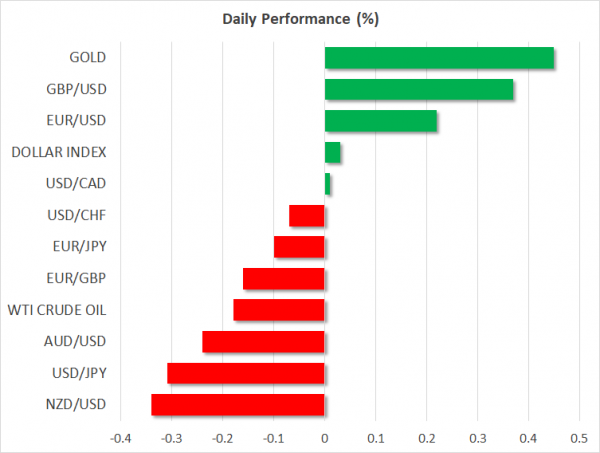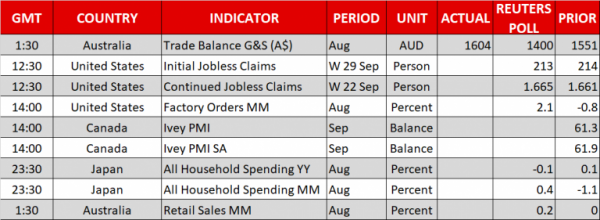Here are the latest developments in global markets:
- FOREX: The US dollar retreated by 0.33% to 114.16 against the Japanese yen on Thursday after topping at 114.54 on Wednesday, the highest in 11 months. Following yesterday’s positive US data and hawkish comments from Federal Reserve Chairman Jerome Powell, US 10-year government bond yields spiked as high as 3.23% today, a level never seen since June 2011. Powell said that interest rates still have a long way to go to reach neutral levels, flagging that additional rate hikes are coming. The dollar index inched up to 95.81 (+0.06%). Euro/dollar was trying to pare some losses (+0.23%) which drove the pair to a six-week low of 1.1462 today. Pound/dollar regained some ground to trade at 1.2986, rising by 0.37%. In antipodean currencies, aussie/dollar and kiwi/dollar reached fresh 32-month lows at 0.7063 and 0.6481 respectively, losing more than 0.30% in the day, even with the dollar being on the back foot itself. Dollar/loonie struggled near its opening level, trading around 1.2867. In emerging market currencies, the Turkish lira plummeted by 1.70% versus the greenback, after the nation’s inflation rate soared to 25.5% in annual terms, data showed yesterday.
- STOCKS: Shares in Europe felt the pain from ascending global yields as Japanese and German government bond yields picked up speed as well. The pan-European STOXX 600 was down by 0.67% with all sectors apart financials in the red, while the blue-chip Euro STOXX 50 declined by 0.51% at 1200 GMT. The German DAX 30 and the Spanish IBEX 35 were steady, the French CAC 40 plunged by 0.90% and UK’s FTSE 100 plummeted by 0.86%. The Italian FTSE MIB lost 0.19%. Futures tracking US stock indices were all in the red, pointing to a negative open today despite the Dow Jones touching a fresh all-time high of 26951 yesterday.
- COMMODITIES: Oil prices remained slightly below Wednesday’s 4-year highs supported by forthcoming losses in Iranian supply as a new round of US sanctions is set to kick in by early November. WTI crude oil headed lower by 0.24% to $76.23/barrel, while London-based Brent fell by 0.22% around $86.00/barrel. Gold prices were flirting with the $1,200/ounce level (+0.54%).
Day Ahead: US Factory orders eyed for further dollar rally; Brexit and Italian budget to remain in the spotlight
Upbeat data releases out of the US combined with hawkish comments delivered by the Fed chairman Jerome Powell on Wednesday were enough to enhance hopes for further rate hikes in the future and thus boost the dollar. On Thursday, while a few data releases are pending in the remainder of the day, investors will keep a close eye on US factory orders due at 1500 GMT. According to analysts, new purchase orders placed with manufacturers are expected to have expanded by 2.1% month-on-month (m/m) in August, posting a spectacular recovery after decreasing by 0.8% in July. Should the measure print stronger growth than expected, the dollar could unlock fresh highs, while US government bond yields will be in focus as well, as the 10-year bond yields are currently at their highest since 2011. Emerging market currencies might come under pressure once again if the dollar continues to gain ground.
Earlier at 1230 GTM, initial jobless claims for the week ending September 29 may come under review as well, though the market reaction on the data is typically limited.
In neighboring Canada, where trade fears substantially receded after the US, Canada and Mexico managed to reach a new trilateral agreement, attention will turn to the Ivey PMI readings for the month of September later in the day (1400 GMT). Yet the numbers could have a minimal impact on the loonie as investors may be more interested about Friday’s employment figures out of Canada and the US. Fluctuations in oil prices may also affect the commodity-linked loonie.
Elsewhere, Japan is scheduled to publish September’s household spending figures at 2330 GMT. Forecasts are for consumption to have eased to -0.1% on a yearly basis. In July the measure marked a soft increase of 0.1%. Meanwhile the International Monetary Fund judged that downside risks to the Japanese economy have increased in the past year due to trade barriers which threaten to pressure demand for Japanese exports. Moreover, the IMF sees rises in sales taxes planned for next year weighing on growth momentum too, messaging that monetary policy should stay accommodative for now.
Early on Friday, Australian retail sales could move the aussie at 0130 GMT. Analysts believe that retail sales in August increased by 0.2% m/m after showing no growth in the preceding month.
Brexit will remain under the spotlight as markets eagerly await the UK to unveil new proposals on the Irish border before EU summit on October 17-18.
In the Eurozone, Italy’s fiscal policy will continue to limit upside movements in the euro. On Wednesday, the Italian Prime Minister confirmed that the deficit target for 2019 will be 2.4% of GDP, while the goals for 2020 and 2021 would fall to 2.1% and 1.8% respectively versus the 2.4% reported earlier for both years. Yet the government still needs to send full details of its spending plans to the Italian parliament before it submits a budget draft to the European Commission in mid-October.














